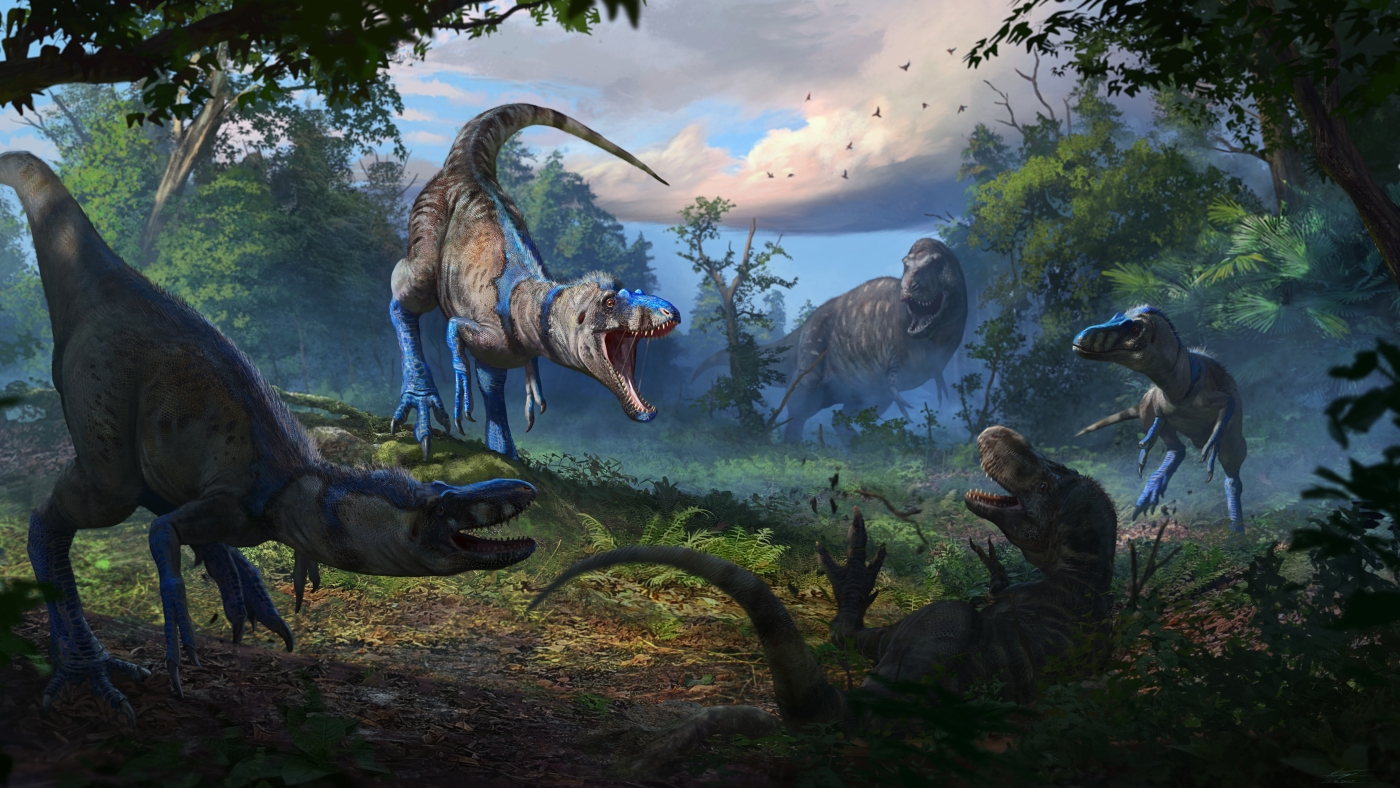In this illustration, a pack of Nanotyrannus attacks a juvenile T. rex. Scientists say a well-known fossil shows that there was more than one tyrannosaur species roaming the Earth.
Anthony Hutchings/Friends of the NC Museum of Natural Sciences
hide caption
toggle caption
Anthony Hutchings/Friends of the NC Museum of Natural Sciences
It’s known as the “Dueling Dinosaurs” fossil: A triceratops and a tyrannosaur, skeletons entangled, locked in apparent combat right up until the moment of their mutual demise.
Even in the Hell Creek Formation in eastern Montana, a spot known for great finds, this specimen was, in a word, “fantabulous,” says Clayton Phipps, a self-described rancher, cowboy and dinosaur hunter.
That discovery in 2006 now appears to have overturned decades of dinosaur dogma about Tyrannosaurus rex, the fearsome giant long thought to be the sole top predator stalking the late Cretaceous. In a paper in the journal Nature, paleontologists Lindsay Zanno and James Napoli conclude that some of the bones from that specimen belong not to a teenage T. rex, but to a fully grown individual of a different tyrannosaur species — Nanotyrannus lancensis.
The majority of paleontologists, after some debate, had dismissed the idea that any other tyrannosaurs existed besides T. rex. And yet, the sands of Montana seem to have disgorged a second one. In a broader analysis of other fossils, the two researchers also uncovered what they say is a third tyrannosaur species, formerly presumed to be a juvenile T. rex.
“We knew the specimen was exceptional,” says Zanno. “We did not realize it would turn decades of research about T. rex on its head.”
“Just insanely good”
The Montana dig began on a breezy summer day when Phipps’ friend, Mark Eatman, found an exposed pelvis and femur at the bottom of a canyon. Phipps thought maybe there was half a dinosaur hidden below.
But after two weeks of digging, Phipps and his older cousin revealed that those bones belonged to a stunning triceratops.
“It was crazier than any site I’ve ever done before or since because every bone is in place,” he says. “The skeleton was just all together — just insanely good.”
Then, while excavating the light yellow sand from around the specimen, Phipps spotted something the color of chocolate. It was a claw.
But triceratops didn’t have claws.
“I’m like, ‘What?’ I start brushing and all of a sudden this arm starts to appear and part of the leg,” he recalls. “Oh man, my hat went in the air about 200 feet. I was like, ‘No way — there’s another dinosaur in here.'”
This was a bipedal, carnivorous dinosaur, entwined with the triceratops. “Just laying like they died,” says Phipps.
The scientific consensus pegged this second dinosaur as a teenage Tyrannosaurus rex — a conclusion that would soon be overturned.
Teenage angst
A few years ago, the nonprofit Friends of the North Carolina Museum of Natural Sciences acquired the fossils and rock they were encased in (some 30,000 pounds) from Phipps and donated them to the museum. “They were a Christmas present waiting to be unwrapped,” he says.
Zanno, who is head of paleontology at the museum, was thrilled. “It’s one of the most incredible specimens from the late Cretaceous in North America I’ve ever seen,” she says.
She and the museum built an entire wing around the dueling dinosaurs to house a live-action research experience. “It’s the only place in the world where you get to enter the working paleo-lab without a barrier and talk to the scientific team that’s working on the fossils,” says Zanno.
Visitors to the North Carolina Museum of Natural Sciences get a closeup look at the “Dueling Dinosaurs” fossil, an entwined tyrannosaur and stegosaurus. This specimen has upended many longstanding beliefs about Tyrannosaurus rex.
North Carolina Museum of Natural Sciences
hide caption
toggle caption
North Carolina Museum of Natural Sciences
When that work began, Zanno also figured the carnivorous dinosaur was the world’s most complete juvenile T. rex ever found. “But as soon as we started actually studying this specimen, we realized there were a lot of red flags,” she says.
For context, paleontologists had previously debated whether small-bodied tyrannosaurs were teenage T. rexes or a different species altogether. The existence of a two-legged tyrannosaur species that lived alongside T. rex was proposed back in the 1940s, but had long since fallen out of favor.
The consensus converged on juvenile T. rex, “meaning it would have been the only major predator in end-Cretaceous ecosystems right before the asteroid impact,” says Zanno. Most researchers believed that T. rex — which could be 12 feet high, 40 feet long and weigh around 15,000 pounds — had outcompeted all other meat-eating dinosaurs.
The completeness of the new skeleton provided Zanno with the ideal specimen to test these long-standing conclusions.
“This is such a controversial topic,” she says. “And we don’t want to write another paper that just stirs the pot. We want to write the paper that ends the debate.”
The dueling dinosaurs settle a duel
One of the first of those red flags in the new specimen was the arm bones. They looked completely different than T. rex‘s puny appendages.
“We never had a complete arm of this animal,” says Zanno. “These are powerful arms with large claws, large hands. They were using them for prey capture.” Contrast that with T. rex, “an animal that’s a mouth on legs.”
There were additional clues. The animal had fewer tail vertebrae and more teeth than T. rex. Zanno and Napoli considered other lines of evidence. They created 3D models of numerous purported T. rexes against which they compared their specimen. They looked at the growth stages of the cranial nerves and sinuses of close living relatives of dinosaurs, features that were visible in the fossilized skeleton.
“But maybe the most important and damning thing that we did was we were able to figure out that our animal is not a juvenile at all,” she says. This conclusion was based on slicing through the fossil’s limb bones to examine the growth rings. That work demonstrated that this animal was mature and done growing when it died around the age of 20.
“That means it’s half the size and a tenth of the mass of a full grown Tyrannosaurus rex,” says Zanno.
All of the results point to one conclusion, according to Zanno and Napoli. This was no teen T. rex. This was a fully grown Nanotyrannus lancensis — the same species first identified in the 1940s and later largely dismissed by the paleontological community.
It was “a small, slender pursuit predator that could run under the legs of a T. rex,” explains Zanno.
In addition, while making models of all those other alleged T. rex skeletons, Zanno says they identified another new species of tyrannosaur, one they’re calling Nanotyrannus lethaeus. “The name comes from Greco-Roman mythology for the [Lethe] River where souls used to drink and forget their prior lives and be reincarnated,” she says. “That’s a reference to this animal having been under our nose and not recognized for what it was.”
For years, most researchers believed there was just one tyrannosaur — rex. But now the king has been de-throned. There were at least two other tyrannosaurs holding court.
“It tells us that these end-Cretaceous ecosystems right before the asteroid hit were flourishing,” says Zanno. “They had an abundance of different predators. And refutes this idea that dinosaurs were in decline before the asteroid struck.”
Loving being wrong
Thomas Holtz, a paleontologist at the University of Maryland who wasn’t involved in the research, welcomes the broader picture of tyrannosaur diversity proposed by the new study. “I always said with sufficient evidence, I’d be happy to embrace it,” he says. “And now I can because there’s sufficient evidence. I think they’ve made a very strong case.”
Though, he adds, “We’ll see if it lasts. As I like to point out, taxonomy is not permanent,” referring to the study of how organisms are classified (and, sometimes, re-classified).
Holtz argues that one consequence of the study is that paleontologists no longer know what a juvenile T. rex looked like — because previously assumed “teenagers” were likely Nanotyrannus. That’s an arena of future research and discovery, along with fleshing out the varied biologies and behaviors of this growing group of tyrannosaurs.
Zanno agrees that there remains much to understand. She believes there’s likely to be additional dinosaur species that have been hidden in plain sight in museums and collections across the world.
“This is why I love science,” says Zanno. “I have the only job in the world where my job is to second-guess myself every day and everything I think I know.”
“When it comes to shedding doubt on research on Earth’s most famous dinosaur,” she says, referring to T. rex, “that’s an intimidating endeavor. But this is how we grow as a profession and how we grow as scientists.”
Zanno believes this study will pave the way for paleontologists to look for more complex patterns in this and other prehistoric ecosystems.
“From here forward,” Zanno adds, “what I’m most thrilled about is how much we stand to learn by recognizing that we got it wrong the first time.”
First Appeared on
Source link














